|

translated by Maria Gousseva
original source
from
UFOCaseBooks Website
Is there an "Alien Base" on the Moon?
More and more people are coming forward
with stories that might prove this is true. Rumors say that there is
an Alien Moon Base on the far side of the moon, the side we
never see from Earth.
Did you ever wonder why the Moon landings stopped and why we have
not tried to build a Moon Base?
It does seem like a better and easier
idea than a floating space station with no access to any raw
materials or supplies. According to the NASA Astronaut Neil
Armstrong the aliens have a base on the Moon and told us
in no uncertain terms to get off and stay off the Moon!
Sound far fetched?
Milton Cooper, a Naval
Intelligence Officer tells us that not only does the Alien Moon
Base exist but the U.S.
Naval Intelligence Community refers to
the Alien Moon Base as "Luna," that there is a huge mining
operation going on there, and that is where the aliens keep their
huge mother ships while the trips to Earth are made in smaller
"flying saucers".
Did Apollo 11 Encounter UFOs on the Moon?
from the Book "Above
Top Secret"
by Timothy Good.
LUNA: The Alien base on the far side
of the Moon. It was seen and filmed by the
Apollo astronauts. A
base, a mining operation using very large machines, and the very
large alien craft described in sighting reports as mother ships
exist there.
-Milton Cooper

Buzz Aldrin
According to hitherto unconfirmed
reports, both Neil Armstrong and Edwin "Buzz"
Aldrin saw UFOs shortly after their historic landing on the
Moon in Apollo 11 on 21 July 1969.
I remember hearing one of the
astronauts refer to a "light" in or on a carter during the
television transmission, followed by a request from mission
control for further information. Nothing more was heard.
According to a former NASA employee Otto Binder, unnamed
radio hams with their own VHF receiving facilities that bypassed
NASA's broadcasting outlets picked up the following exchange:
NASA: What's there?
Mission Control calling Apollo 11...
Apollo: These "Babies" are huge, Sir! Enormous! OH MY
GOD! You wouldn't believe it! I'm telling you there are
other spacecraft out there, lined up on the far side of the
crater edge! They're on the Moon watching us!
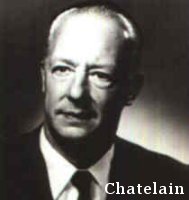
Maurice Chatelain
In 1979, Maurice Chatelain,
former chief of NASA Communications Systems confirmed
that Armstrong had indeed reported seeing two UFOs on the rim of
a crater.
"The encounter was common
knowledge in NASA," he revealed, "but nobody has talked
about it until now."
Soviet scientists were allegedly the
first to confirm the incident.
"According to our information,
the encounter was reported immediately after the landing of
the module," said Dr. Vladimir Azhazha, a physicist
and Professor of Mathematics at Moscow University.
"Neil Armstrong relayed the
message to Mission Control that two large, mysterious
objects were watching them after having landed near the moon
module. But his message was never heard by the
public-because NASA censored it. "
According to another Soviet
scientist, Dr. Aleksandr Kazantsev, Buzz Aldrin took
color movie film of the UFOs from inside the module, and
continued filming them after he and Armstrong went outside.
Dr. Azhazha claims that the UFOs
departed minutes after the astronauts came out on to the lunar
surface.
Maurice Chatelain also confirmed that Apollo 11's radio
transmissions were interrupted on several occasions in order to
hide the news from the public. Before dismissing Chatelain's
sensational claims, it is worth noting his impressive background
in the aerospace industry and space program.
His first job after moving from
France was as an electronics engineer with Convair,
specializing in telecommunications, telemetry, and radar. In
1959 he was in charge of an electromagnetic research group,
developing new radar and telecommunications systems for Ryan.
One of his eleven patents was an automatic flights to the
Moon.
Later, at North American Aviation,
Chatelain was offered the job of designing and building the
Apollo communications and data-processing systems.
Chatelain claims that,
"all Apollo and Gemini flights
were followed, both at a distance and sometimes also quite
closely, by space vehicles of extraterrestrial origin-flying
saucers, or UFOs, if you want to call them by that name.
Every time it occurred, the astronauts informed Mission
Control, who then ordered absolute silence."
He goes on to say:
"I think that Walter Schirra
aboard Mercury 8 was the first of the astronauts to use the
code name 'Santa Claus' to indicate the presence of
flying saucers next to space capsules. However, his
announcements were barely noticed by the general public.
It was a little different when James Lovell on board
the Apollo 8 command module came out from behind the moon
and said for everybody to hear:
'PLEASE BE INFORMED THAT
THERE IS A SANTA CLAUS.'
Even though this happened on
Christmas Day 1968, many people sensed a hidden meaning in
those words."
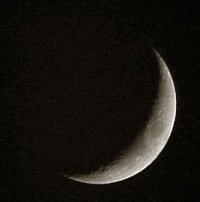 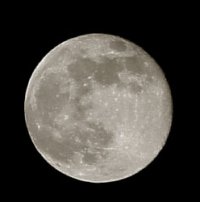
Rumors persist.
NASA may well be a
civilian agency, but many of its programs are funded by the
defense budget and most of the astronauts are subject to
military security regulations.
Apart from the fact that the
National Security Agency screens all films and probably radio
communications as well. We have the statements by Otto Binder,
Dr. Garry Henderson and Maurice Chatelain that the
astronauts were under strict orders not to discuss their
sightings.
And Gordon Cooper has
testified to a United Nations committee that one of the
astronauts actually witnessed a UFO on the ground.
If there is no secrecy, why has this
sighting not been made public?
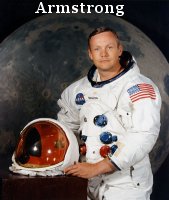
Neil Armstrong
A certain professor, who wished to
remain anonymous, was engaged in a discussion with Neil
Armstrong during a NASA symposium.
Professor: What REALLY
happened out there with Apollo 11?
Armstrong: It was incredible, of course we had always
known there was a possibility, the fact is, we were warned
off! (by the Aliens) There was never any question then of a
space station or a moon city.
Professor: How do you mean "warned off"?
Armstrong: I can't go into details, except to say
that their ships were far superior to ours both in size and
technology. Boy, were they big!... and menacing! No, there
is no question of a space station.
Professor: But NASA had other missions after Apollo
11?
Armstrong: Naturally. NASA was committed at that
time, and couldn't risk panic on Earth. But it really was a
quick scoop and back again.
Armstrong confirmed that the story
was true but refused to go into further detail, beyond admitting
that the CIA was behind the cover-up.
More information in
Cities Found on the Moon!
UPDATED INFO
New crater revives
Moon mystery
by Jeff Hecht
Special Report from New Scientist
Print Edition
11 January 2003
A
mysterious flash on the Moon caught
on camera 50 years ago is still provoking disagreements about its
origin. Astronomer Bonnie Buratti says her new results show
that the flash was caused by a 20-metre asteroid hitting the Moon.
If Buratti is right, such impacts may be more frequent than
thought-about once every 30 years on the Earth, and every 500 years
on the Moon. But other asteroid watchers think the flash was due to
a small meteor burning up in Earth's atmosphere.
Amateur astronomer Leon Stuart's 1953 photograph of the Moon
shows a light spot near the centre of the
Moon's visible surface.
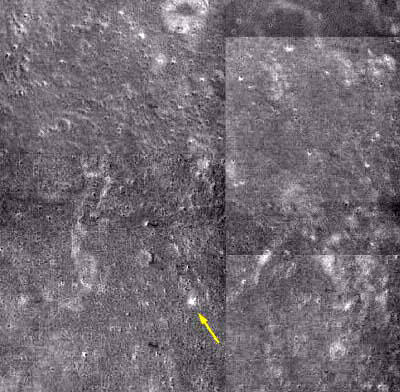
It would take a half-megaton explosion
to produce such a flash, says Buratti, of NASA's Jet Propulsion
Laboratory at Pasadena.
The resulting crater would not be
visible from Earth, but it should appear on close-ups taken by lunar
probes. In a future issue of the journal Icarus, Buratti reports a
fresh impact scar at the site of the 1953 flash on images collected
by the Clementine spacecraft as it orbited the Moon in 1994.
A bright blanket of ejected material
covers an area that is about 1.5 kilometers across, and the color of
the debris indicates that the crater is relatively new.
Point meteors
But the odds against such a
big lunar impact are too long for Peter Brown of the
University of Western Ontario, who has used US military satellite
data to estimate meteor impact rates on the Earth.
"I think they are going too far," he
told New Scientist.
Instead, he believes that the flash was
a meteor falling to Earth, which appeared as a bright spot because
it was moving directly towards the observer. Although such "point
meteors" are rare, they are much more common than lunar impacts.
He is not impressed by the crater's
appearance.
"We have no absolute criteria" for
the age of lunar craters, he says. "'Fresh' could be 20 million
years old."
Buratti calls Brown's claim
"preposterous".
She says Stuart was an experienced
observer, his half-second exposure shows no trace of motion, and the
flash was near a point on the leading edge of the Moon where impacts
are most likely.
"Our identification of the crater
validates Stuart's claim that it was an impact."
|






